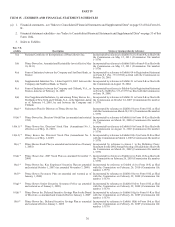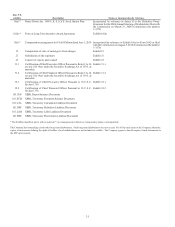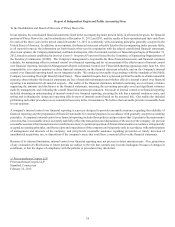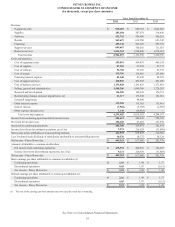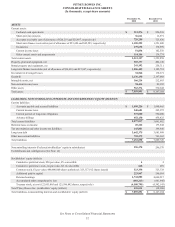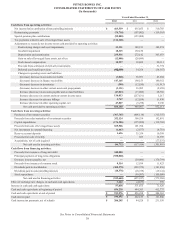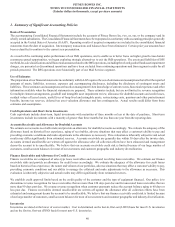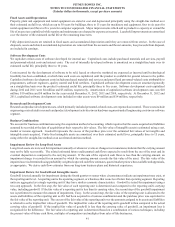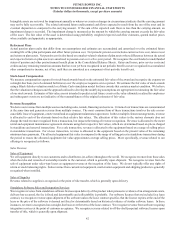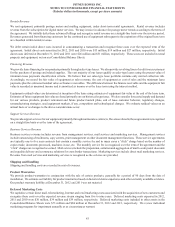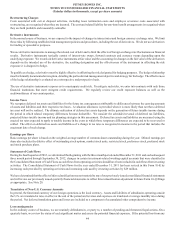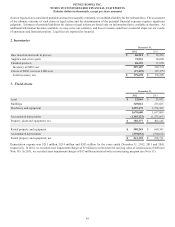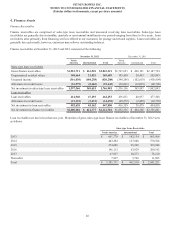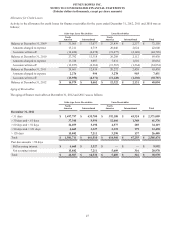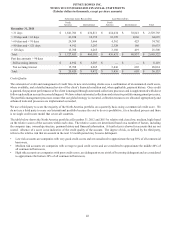Pitney Bowes 2012 Annual Report Download - page 58
Download and view the complete annual report
Please find page 58 of the 2012 Pitney Bowes annual report below. You can navigate through the pages in the report by either clicking on the pages listed below, or by using the keyword search tool below to find specific information within the annual report.PITNEY BOWES INC.
NOTES TO CONSOLIDATED FINANCIAL STATEMENTS
(Tabular dollars in thousands, except per share amounts)
40
1. Summary of Significant Accounting Policies
Basis of Presentation
The accompanying Consolidated Financial Statements include the accounts of Pitney Bowes Inc. (we, us, our, or the company) and its
wholly owned subsidiaries. The Consolidated Financial Statements have been prepared in conformity with accounting principles generally
accepted in the United States of America (GAAP). Operating results of acquired companies are included in the consolidated financial
statements from the date of acquisition. Intercompany transactions and balances have been eliminated. Certain prior year amounts have
been reclassified to conform to the current year presentation.
As a result of the continuing under-performance of our IMS operations, and to enable us to better focus on higher growth cross-border
ecommerce parcel opportunities, we began exploring strategic alternatives to exit the IMS operations. The assets and liabilities of IMS
met held-for-sale classification and all historical amounts related to the IMS operations, including the related goodwill and asset impairment
charges, are presented as discontinued operations and have been excluded from continuing operations and from segment results for all
periods presented. The IMS operations were historically part of our Mail Services segment.
Use of Estimates
The preparation of our financial statements in conformity with GAAP requires the use of estimates and assumptions that affect the reported
amounts of assets, liabilities, revenues, expenses and accompanying disclosures, including the disclosure of contingent assets and
liabilities. These estimates and assumptions are based on management's best knowledge of current events, historical experience and other
information available when the financial statements are prepared. These estimates include, but are not limited to, revenue recognition
for multiple element arrangements, goodwill and intangible asset impairment review, allowance for doubtful accounts and credit losses,
residual values of leased assets, useful lives of long-lived and intangible assets, restructuring costs, pensions and other postretirement
benefits, income tax reserves, deferred tax asset valuation allowance and loss contingencies. Actual results could differ from those
estimates and assumptions.
Cash Equivalents and Short-Term Investments
Cash equivalents include short-term, liquid investments with maturities of three months or less at the date of purchase. Short-term
investments include investments with a maturity of greater than three months but less than one year from the reporting date.
Accounts Receivable and Allowance for Doubtful Accounts
We estimate our accounts receivable risks and provide an allowance for doubtful accounts accordingly. We evaluate the adequacy of the
allowance based on historical loss experience, aging of receivables, adverse situations that may affect a customer's ability to pay and
prevailing economic conditions and make adjustments to the allowance as necessary. This evaluation is inherently subjective and actual
results may differ significantly from estimated reserves. Accounts receivable are generally due within 30 days after the invoice date.
Accounts deemed uncollectible are written off against the allowance after all collection efforts have been exhausted and management
deems the account to be uncollectible. We believe that our accounts receivable credit risk is limited because of our large number of
customers, small account balances for most of our customers and customer geographic and industry diversification.
Finance Receivables and Allowance for Credit Losses
Finance receivables are composed of sales-type lease receivables and unsecured revolving loan receivables. We estimate our finance
receivable risks and provide an allowance for credit losses accordingly. We evaluate the adequacy of the allowance for credit losses
based on historical loss experience, the nature and volume of our portfolios, adverse situations that may affect a customer's ability to pay,
prevailing economic conditions and our ability to manage the collateral and make adjustments to the allowance as necessary. This
evaluation is inherently subjective and actual results may differ significantly from estimated reserves.
We establish credit approval limits based on the credit quality of the customer and the type of equipment financed. Our policy is to
discontinue revenue recognition for lease receivables that are more than 120 days past due and for unsecured loan receivables that are
more than 90 days past due. We resume revenue recognition when customer payments reduce the account balance aging to 60 days or
less past due. Finance receivables deemed uncollectible are written off against the allowance after all collection efforts have been
exhausted and management deems the account to be uncollectible. We believe that our finance receivable credit risk is limited because
of our large number of customers, small account balances for most of our customers and customer geographic and industry diversification.
Inventories
Inventories are stated at the lower of cost or market. Cost is determined on the last-in, first-out (LIFO) basis for most U.S. inventories
and on the first-in, first-out (FIFO) basis for most non-U.S. inventories.


